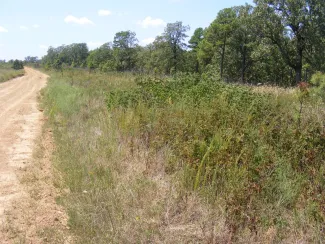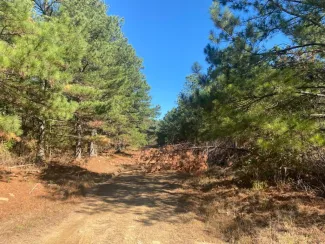Roads and trails play an important role on the properties we access and enjoy. Without them we’d likely have to do plenty of hiking, but with them comes a multitude of benefits and challenges in their use and maintenance. Roads surrounded by forest offer a unique management opportunity too – daylighting.
Daylighting is the process of removing the tree cover along one or both sides of a road or trail. This management practice can have many benefits, and not just for wildlife.

For one, removing the tree cover can greatly reduce the maintenance cost of a road by increasing the amount of sunlight and wind reaching the road surface. As nearly all land managers can attest, a dry road surface can be safely navigated by vehicles with very little impact. Soggy roads, on the other hand, can suffer great damage and may require time and money to repair.
A second benefit of daylighting forest roads is eliminating the need to remove downed trees. Inevitably, every tree will fall to the ground, and some may entirely or partially block a roadway. Daylighting is a good way to prevent this, especially if the height of the trees is considered and the width of the daylighted area managed accordingly.

Of course, there are numerous wildlife benefits to daylighting. In essence, daylighting increases edge by promoting early successional habitat between the road and forest. These managed roadsides are usually devoid of trees, and the abundant sunlight allows grassy, wildflower, and shrubby communities to develop. White-tailed deer, wild turkeys, northern bobwhite, eastern cottontails, songbirds, pollinators, and many other species readily use opened road habitats for the food, cover and other important habitat components and resources they offer. In many cases, daylighting may be exactly what’s needed to add the habitat diversity and connectivity that’s required for the species of wildlife that many landowners desire.
Another consideration for any daylighting project is combining it with other valuable practices. For a dense, mature forest that is adjacent to a 30- or 60-foot-wide open roadside, early successional habitat is good, but a softer transition between the two plant communities is better. Remember, a well-managed roadside habitat is devoid of trees and it’s better to feather the remaining tree line than leave it dense. Removing 50% of the trees within a 25-to-50-foot strip into the forest will create a feathered transition that will be very attractive to a large variety of highly desirable wildlife species.
Maintenance, too, is important when it comes to managing roadside habitats. The early successional habitat that develops after daylighting is diverse with many valuable annual and perennial grasses, wildflowers, vines, and shrubs. Bare ground is also common and foraging, nesting, and brood-rearing conditions are usually excellent. Left unmanaged, these roadside areas will naturally transition back into forest communities, offsetting the time and money it took to establish such important habitats. However, prescribed fire, woody control through spraying, strategic mowing (to control woody plants), and disking every two to five years can help maintain roadside areas in optimum early to mid-successional conditions that benefit many species.
It must be mentioned that daylighting may not be suitable for all roadways. Some roads are lined with excessive slopes where erosion can become a concern if the soil is exposed. Daylighting along public roadways may also lead to an increase in illegal hunting, especially road hunting. An increase in vehicle traffic can also occur when roadsides are opened, and this increase can disturb nesting birds or result in more vehicle/animal collisions.
Overall, daylighting along a forest road can have many wildlife and maintenance benefits, but these must be weighed against potential issues. Visiting with your local private lands biologist or forester is a good way to get started.